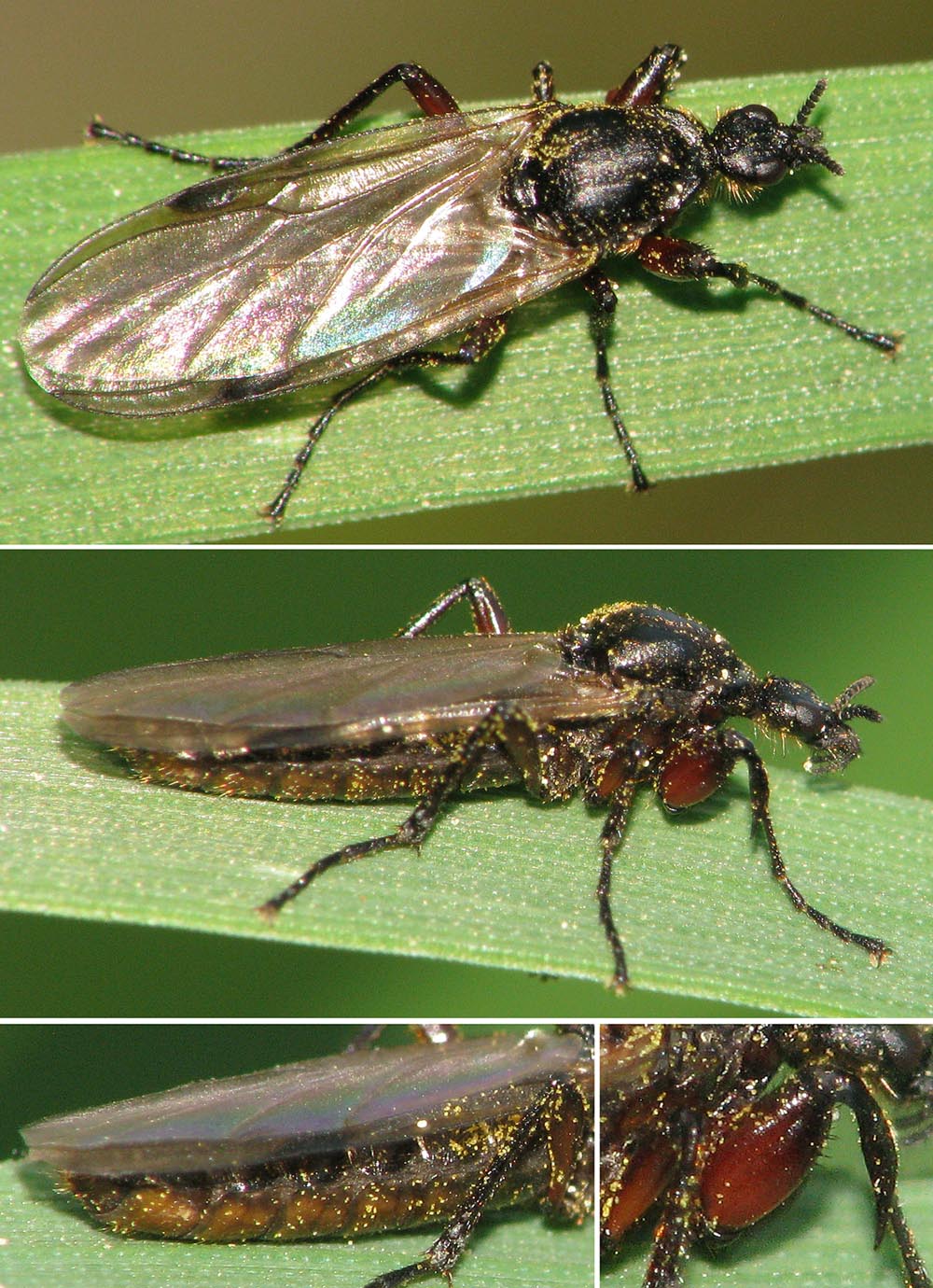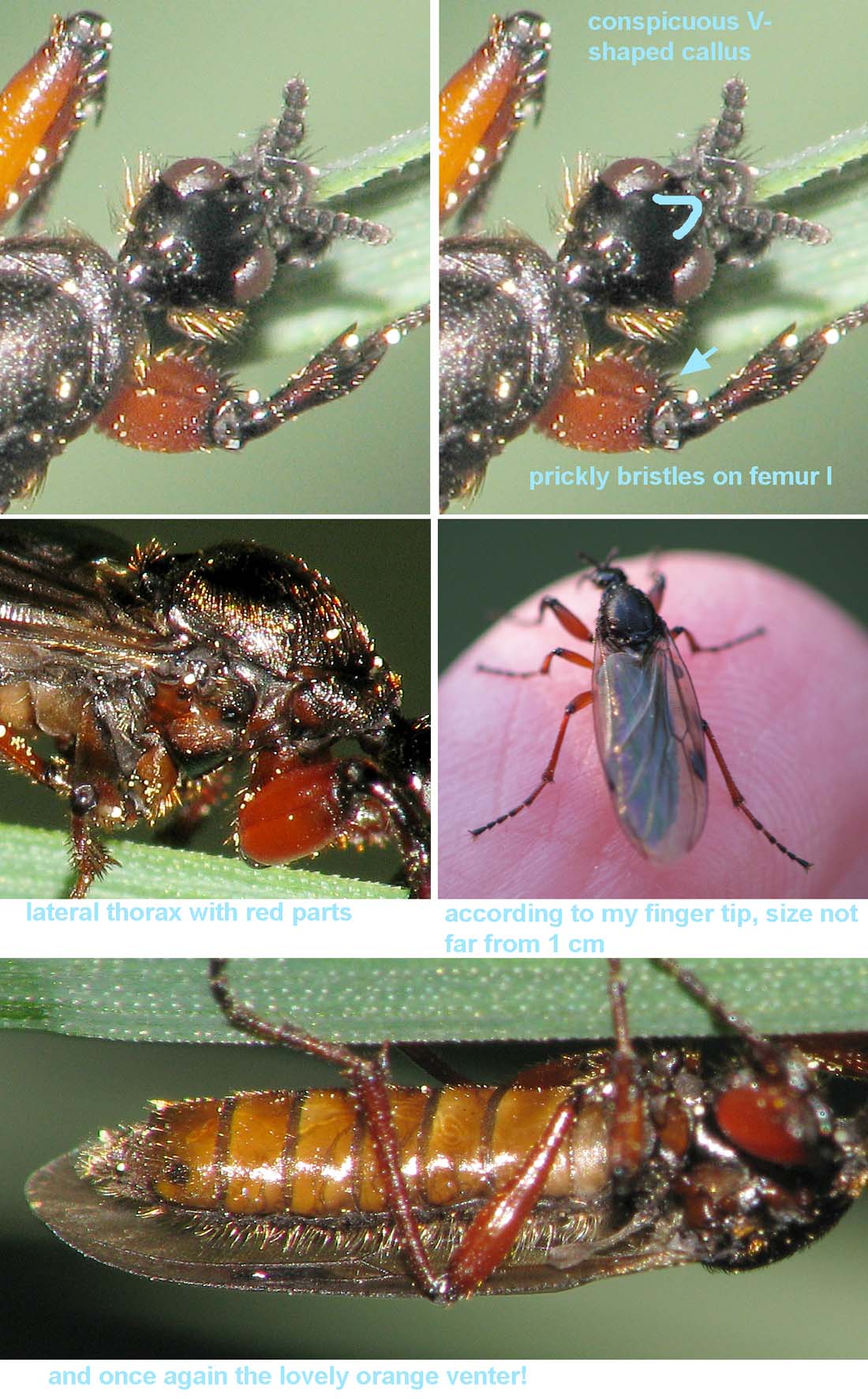Diptera.info :: Identification queries :: Diptera (adults)
Who is here? 1 guest(s)
|
Bibio varipes female - new hints!
|
|
| Sundew |
Posted on 24-04-2020 23:17
|
|
Member Location: Berlin and Baden-Württemberg, Germany Posts: 3939 Joined: 28.07.07 |
Hi, Recently I saw this Bibio female in southwestern Germany, about 20 km west of Stuttgart. I think it might be B. varipes. As mentioned in my comment about thread https://diptera.i...d_id=94616, I read the description by Loew in Linnaea Entomologica (1846, https://www.biodi...3/mode/1up) who states that B. varipes females have a dirty yellow venter and reddish spots on the thorax sides. The short bristles on the lower side of the very thickened front femora are stiff and rather prickly. On the contrary, B. johannis females are said to have a completely black abdomen, and there seem to be no "specialized" bristles on the front femora. How reliable are these traits? They might be very helpful in identification. Thanks for enlightening me! Sundew Sundew attached the following image:  [265.1Kb] Edited by Sundew on 28-04-2020 18:02 |
|
|
|
| Zeegers |
Posted on 25-04-2020 07:25
|
|
Member Location: Soest, NL Posts: 19248 Joined: 21.07.04 |
Females in the varipes / johannis / lanigerus are very difficult and I defintitely would not lean on a 150 years old quote, even if Loew’s. To be honest, pterostigma is very dark, suggesting johannis. Varipes is relatively rare and mostly found in wooden areas. Theo |
|
|
|
| Sundew |
Posted on 25-04-2020 14:48
|
|
Member Location: Berlin and Baden-Württemberg, Germany Posts: 3939 Joined: 28.07.07 |
So we reached an impasse here (and I was so impressed by the yellow sternites!). And I admire the 19th century biologists - they looked so closely and described so meticulously, even if they sometimes overvalued minor differences. Steven Falk says, "B. varipes is widespread and can be the commonest spring Bibio in many districts, especially in woods." That doesn't just apply to Great Britain. And his locality picture (https://www.flick...181555290/) looks exactly like the glade where I saw my female. There are many Bibios at the moment - marci, venosus, certainly johannis, and this one... However, dear Theo, I absolutely agree with your statement, "If you follow your lead, you end up with more females varipes than males, which is statistically highly improbable." I think I will label the photo "cf. varipes" and add our interesting discussion. Always so helpful - thanks! Sundew Edited by Sundew on 25-04-2020 14:50 |
|
|
|
| Zeegers |
Posted on 27-04-2020 17:28
|
|
Member Location: Soest, NL Posts: 19248 Joined: 21.07.04 |
the only way to go with female Bibio, in my opinion, is Verbeke (1971) [ Bull. inst. r. Sci. nat Belg. 47-23. Yes, female varipes have red venter, but so do many lanigerus. The hind metatarsus is much shorter in johannis than in your picture, so it is pretty safe to say this is not johannis. As you mentioned, johannis has dark venter. There are several very subtle features separating varipes from johannis, but based on these pictures, I would not dare to make the call. The reddish sport on pleura is not very convincing here (much clearer in my material) and the shape of the prothorax suggests lanigerus rather than varipes. So, I wished I had taken my own advice: don't go here, unless you can associate your female with a male .... Theo |
|
|
|
| Sundew |
Posted on 28-04-2020 17:54
|
|
Member Location: Berlin and Baden-Württemberg, Germany Posts: 3939 Joined: 28.07.07 |
Dear Theo, I see my fly is still working in your brain! Many thanks for pointing out the valuable paper by Verbeke, it's great. I'd like to sum up the clues in his key for females: As you said, metatarsus 3 is too long for B. johannis. So we have to discriminate between B. lanigerus and B. varipes. Both are said to have a bulge (callus) between the eyes just before insertion of the antennae. B. lanigerus: - small species - callus small, round, inconspicuous - thorax completely black - femur 1 with fine yellow pilosity, hairs not prickly B. varipes: - bigger and robuster - callus conspicuous, in the shape of a "V" - thorax reddish on the pleura - antero- and posteroventral pilosity of femur 1 conspicuously prickly So, to me all these characters clearly point to B. varipes! I add another picture to illustrate them. Can I convince you? Best wishes, Claudia (Sundew) Sundew attached the following image:  [233.96Kb] |
|
|
|
| libor |
Posted on 28-04-2020 22:26
|
|
Member Location: western Bohemia Posts: 1294 Joined: 30.05.09 |
Thanks to both of you for the exciting discussion! Please, can I get the PDF of Verbeke 1971? Libor |
|
|
|
| Sundew |
Posted on 29-04-2020 00:28
|
|
Member Location: Berlin and Baden-Württemberg, Germany Posts: 3939 Joined: 28.07.07 |
Libor: here is the URL: http://biblio.nat...tin-23.pdf This is a really comprehensive paper! |
|
|
|
| Zeegers |
Posted on 29-04-2020 07:19
|
|
Member Location: Soest, NL Posts: 19248 Joined: 21.07.04 |
This is a nice a nice example how science should work “to question the answers”. In this case, I agree you likely have female varipes. Still, I have a female varipes from a locality where I have never found a male. This slightly bothers me. Even Verbeke is not above questioning. We should have more couples to make more progress. Somehow, copulae varioes seem rare. I may add a personal feature candidate, not mentioned by Verbeke: in lanigerus, the haltee is black, whereas its knob is light in varipes. Well shown in your last picture. Thanks Theo |
|
|
|
| Jump to Forum: |












